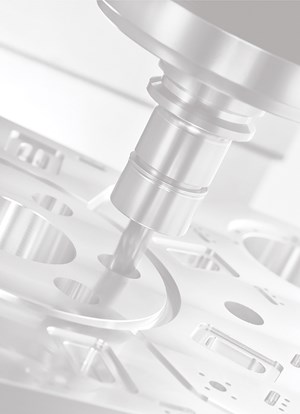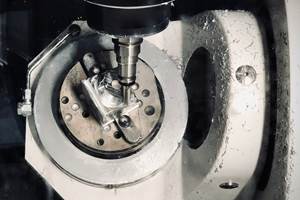Incorporating Automation into EDM
Adding automation to EDM can provide long periods of unattended machining or be used in a closed-loop cell, while EDM control features can automate electrode design and process parameters.
Share




MC Machinery Systems’ Technology Summit featured demonstrations of EDM, milling and other machining applications, including this MV1200-R wire EDM. It has a clamping system with a rotary axis, along with rotary axes for the wire. Photos by Modern Machine Shop.
EDMs are ideal for lights-out machining. The process’s typically long cycle times enable these machines to run unattended, even without a robot or pallet system. But adding an automation system can give users multiday stretches of unattended machining. Beyond machine tending, advanced control features can help automate electrode design and programming processes. Automation can then connect multiple machining processes into a closed-loop cell, not only producing parts without human intervention, but also adjusting parameters automatically to ensure parts remain within tolerance.
MC Machinery Systems’ Technology Summit, which was held October 9 at its Elk Grove Village, Illinois, headquarters, showed off not only its EDMs and mills, but also automation solutions for these machines.

The MV1200-R was tended by a Mitsubishi robot arm. This setup provides as much as 80 hours of unattended machining time.
Wire EDM
For wire EDM users, MC Machinery showcased its MV1200-R. The machine was equipped with a clamping system from Carl Hirschmann that holds the workpiece horizontally on a rotating C-axis. The machine also has U- and V-rotary axes for the wire, enabling more complex geometries. The demo at the event included a robotic cell, also from MC Machinery, that tended the machine, loading a variety of workpieces into the clamping system. With automation, the limiting factor on the machine’s unattended machining time is the wire’s 80-hour life.

The company also displayed a sinker EDM application where the toolchanger brought workpieces to an electrode on the machine table. Using the toolchanger for workpieces is an easy way to implement automation for smaller parts.
Sinker EDM
The event also showcased the SG28 sinker EDM. The demonstration showed a reversed EDM configuration: Instead of the toolchanger bringing electrodes to a workpiece mounted on the machine table, the electrodes were mounted in the machine while the toolchanger brought workpieces (in this case, solenoids) to the electrodes. This provides an easy-to-integrate form of automation for smaller parts.

The M800 series is MC Machinery Systems’ latest generation control. It has features to help with EDM processes, including databases of information to help with programming and electrode design, as well as adaptive control to adjust parameters as needed.
Controls
Both EDMs featured Mitsubishi’s M800 series control with features that can help automate aspects of EDM work, including a database of workpiece materials, electrical parameters and other factors to help produce workpieces with the proper tolerances and surface finishes. The control can also aid users in electrode design, determining the electrode size that will produce correct final workpiece measurements. An adaptive control feature adjusts machine parameters automatically so it’s always operating efficiently but safely — speeding up on simpler features and slowing down on tricky features like sharp points or C-axis changes where the spark gap changes.

The company also highlighted machines it distributes for German builder OPS-Ingersoll, including the Eagle V9 five-axis machine. It can machine metal parts or graphite for electrodes, which can then be incorporated into a closed-loop cell with a robot moving finished electrodes from a milling machine to a measurement system and then to a sinker EDM, all tracked by RFID tags.
Source: Modern Machine Shop
Milling
MC Machinery is also the North American distributor for German builder OPS-Ingersoll. Among the machine tools on display at the summit was OPS-Ingersoll’s Eagle V9. This high-speed, high-rigidity five-axis VMC is suited for machining graphite electrodes and mold components. Although it was demonstrating a metal machining application at the event, OPS-Ingersoll sales manager Mattias Schmidt described how the machine can be integrated into a closed-loop cell. The Eagle V9 machines the graphite electrodes, which are then moved to a CMM via robot for inspection. The electrode is tracked with an RFID tag, so the robot knows when to move it to a sinker EDM to make the next part.
Related Content
Custom Workholding Shaves Days From Medical Part Setup Times
Custom workholding enabled Resolve Surgical Technologies to place all sizes of one trauma part onto a single machine — and cut days from the setup times.
Read MoreHow to Successfully Adopt Five-Axis Machining
While there are many changes to adopt when moving to five-axis, they all compliment the overall goal of better parts through less operations.
Read MoreInside a CNC-Machined Gothic Monastery in Wyoming
An inside look into the Carmelite Monks of Wyoming, who are combining centuries-old Gothic architectural principles with modern CNC machining to build a monastery in the mountains of Wyoming.
Read MoreResults-Driven Innovation on Display at Mazak's DISCOVER 25
DISCOVER 25 attendees will enjoy keynotes and panel presentations, and have a chance to tour the Mazak iSMART Factory where the company “uses Mazaks to make Mazaks.”
Read MoreRead Next
OEM Tour Video: Lean Manufacturing for Measurement and Metrology
How can a facility that requires manual work for some long-standing parts be made more efficient? Join us as we look inside The L. S. Starrett Company’s headquarters in Athol, Massachusetts, and see how this long-established OEM is updating its processes.
Read More

























